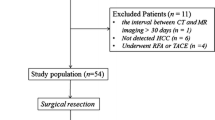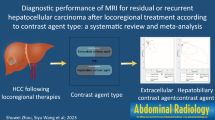Abstract
Objective
To compare the accuracy of multidetector computed tomography (MDCT) and gadoxetic acid-enhanced magnetic resonance imaging (MRI) for the detection of intrahepatic tumor recurrence after curative resection of hepatocellular carcinoma (HCC).
Materials and methods
Fifty-six patients who underwent MDCT and gadoxetic acid-enhanced MRI for postoperative surveillance after resection of HCC were retrospectively analyzed; 26 patients had a recurrence (36 lesions) and 30 patients did not. Recurrent HCCs were confirmed by histological examinations in two, typical dynamic imaging findings on CT and/or MRI in 28, and by demonstration of growth or tumor staining on angiography on six. Two reviewers graded the confidence for the presence of recurrence on CT and MRI, using a five-point scale. The jackknife free-response receiver operating characteristic method was used to compare diagnostic performance. The accuracy, sensitivity, specificity, positive predictive value (PPV), and negative predictive value (NPV) were calculated.
Results
For 36 recurrent lesions, the figure of merit was significantly higher for MRI than MDCT for detecting recurrence for both reviewers (p < 0.005 for both reviewers). In lesion-by-lesion analysis, the sensitivity was significantly higher on MRI (100% for reviewer 1 and 97% for reviewer 2) than on MDCT (44.4% and 66.6%) for both reviewers (p < 0.005 for both reviewers). Also in patient-by-patient analysis, sensitivity was significantly higher on MRI (100% and 96.1%) than on MDCT (57.6% and 76.9%) for both reviewers (p < 0.05 for both reviewers).
Conclusion
Gadoxetic acid-enhanced MRI is superior to MDCT for detecting intrahepatic recurrence after curative resection of HCC.





Similar content being viewed by others
References
Kloeckner R, Otto G, Biesterfeld S, et al. (2010) MDCT versus MRI assessment of tumor response after transarterial chemoembolization for the treatment of hepatocellular carcinoma. Cardiovasc Intervent Radiol 33(3):532–540. doi:10.1007/s00270-009-9728-y
Sun HY, Lee JM, Shin CI, et al. (2010) Gadoxetic acid-enhanced magnetic resonance imaging for differentiating small hepatocellular carcinomas (≤2 cm in diameter) from arterial enhancing pseudolesions: special emphasis on hepatobiliary phase imaging. Invest Radiol 45(2):96–103. doi:10.1097/RLI.0b013e3181c5faf7
Choi GH, Kim DH, Kang CM, et al. (2008) Prognostic factors and optimal treatment strategy for intrahepatic nodular recurrence after curative resection of hepatocellular carcinoma. Ann Surg Oncol 15(2):618–629. doi:10.1245/s10434-007-9671-6
Poon RT, Fan ST, Ng IO, et al. (2000) Different risk factors and prognosis for early and late intrahepatic recurrence after resection of hepatocellular carcinoma. Cancer 89(3):500–507
Nakashima O, Kojiro M (2001) Recurrence of hepatocellular carcinoma: multicentric occurrence or intrahepatic metastasis? A viewpoint in terms of pathology. J Hepatobiliary Pancreat Surg 8(5):404–409
Bruix J, Sherman M (2005) Management of hepatocellular carcinoma. Hepatology (Baltimore, MD) 42(5):1208–1236. doi:10.1002/hep.20933
Chiaramonte M, Stroffolini T, Vian A, et al. (1999) Rate of incidence of hepatocellular carcinoma in patients with compensated viral cirrhosis. Cancer 85(10):2132–2137
Fattovich G, Stroffolini T, Zagni I, Donato F (2004) Hepatocellular carcinoma in cirrhosis: incidence and risk factors. Gastroenterology 127(5 Suppl 1):S35–S50
Poon RT, Fan ST, Lo CM, Liu CL, Wong J (1999) Intrahepatic recurrence after curative resection of hepatocellular carcinoma: long-term results of treatment and prognostic factors. Ann Surg 229(2):216–222
Zhou Y, Sui C, Li B, et al. (2010) Repeat hepatectomy for recurrent hepatocellular carcinoma: a local experience and a systematic review. World J Surg Oncol 8:55. doi:10.1186/1477-7819-8-55
Tung-Ping Poon R, Fan ST, Wong J (2000) Risk factors, prevention, and management of postoperative recurrence after resection of hepatocellular carcinoma. Ann Surg 232(1):10–24
Ando E, Tanaka M, Yamashita F, et al. (2003) Diagnostic clues for recurrent hepatocellular carcinoma: comparison of tumour markers and imaging studies. Eur J Gastroenterol Hepatol 15(6):641–648. doi:10.1097/01.meg.0000059135.68845.70
Ferris JV, Baron RL, Marsh JW Jr, et al. (1996) Recurrent hepatocellular carcinoma after liver transplantation: spectrum of CT findings and recurrence patterns. Radiology 198(1):233–238
Nishizaki T, Takenaka K, Yanaga K, et al. (1997) Early detection of recurrent hepatocellular carcinoma. Hepatogastroenterology 44(14):508–513
Kim SH, Lee J, Kim MJ, et al. (2009) Gadoxetic acid-enhanced MRI versus triple-phase MDCT for the preoperative detection of hepatocellular carcinoma. AJR Am J Roentgenol 192(6):1675–1681. doi:10.2214/ajr.08.1262
Sano K, Ichikawa T, Motosugi U, et al. (2011) Imaging study of early hepatocellular carcinoma: usefulness of gadoxetic acid-enhanced MR imaging. Radiology 261(3):834–844. doi:10.1148/radiol.11101840
Bolondi L, Gaiani S, Celli N, et al. (2005) Characterization of small nodules in cirrhosis by assessment of vascularity: the problem of hypovascular hepatocellular carcinoma. Hepatology (Baltimore, MD) 42(1):27–34. doi:10.1002/hep.20728
Yu JS, Chung JJ, Kim JH, Kim KW (2008) Large (≥2 cm) non-hypervascular nodules depicted on MRI in the cirrhotic liver: fate and implications. Clin Radiol 63(10):1121–1130. doi:10.1016/j.crad.2008.03.005
Chung JJ, Yu JS, Kim JH, Kim MJ, Kim KW (2008) Nonhypervascular hypoattenuating nodules depicted on either portal or equilibrium phase multiphasic CT images in the cirrhotic liver. AJR 191(1):207–214. doi:10.2214/ajr.07.3409,10.2214/ajr.08.1270
Grazioli L, Olivetti L, Fugazzola C, et al. (1999) The pseudocapsule in hepatocellular carcinoma: correlation between dynamic MR imaging and pathology. Eur Radiol 9(1):62–67
Purysko AS, Remer EM, Coppa CP, et al. (2012) LI-RADS: a case-based review of the new categorization of liver findings in patients with end-stage liver disease. Radiographics 32(7):1977–1995. doi:10.1148/rg.327125026
Huppertz A, Haraida S, Kraus A, et al. (2005) Enhancement of focal liver lesions at gadoxetic acid-enhanced MR imaging: correlation with histopathologic findings and spiral CT–initial observations. Radiology 234(2):468–478. doi:10.1148/radiol.2342040278
Frericks BB, Loddenkemper C, Huppertz A, et al. (2009) Qualitative and quantitative evaluation of hepatocellular carcinoma and cirrhotic liver enhancement using Gd-EOB-DTPA. AJR Am J Roentgenol 193(4):1053–1060. doi:10.2214/ajr.08.1946
Krinsky GA, Lee VS, Theise ND, et al. (2001) Hepatocellular carcinoma and dysplastic nodules in patients with cirrhosis: prospective diagnosis with MR imaging and explantation correlation. Radiology 219(2):445–454. doi:10.1148/radiology.219.2.r01ma40445
Tralhao JG, Dagher I, Lino T, Roudie J, Franco D (2007) Treatment of tumour recurrence after resection of hepatocellular carcinoma. Analysis of 97 consecutive patients. Eur J Surg Oncol 33(6):746–751. doi:10.1016/j.ejso.2006.11.015
Shimada K, Sano T, Sakamoto Y, Kosuge T (2005) A long-term follow-up and management study of hepatocellular carcinoma patients surviving for 10 years or longer after curative hepatectomy. Cancer 104(9):1939–1947. doi:10.1002/cncr.21461
Shimozawa N, Hanazaki K (2004) Longterm prognosis after hepatic resection for small hepatocellular carcinoma. J Am Coll Surg 198(3):356–365. doi:10.1016/j.jamcollsurg.2003.10.017
Taura K, Ikai I, Hatano E, et al. (2006) Implication of frequent local ablation therapy for intrahepatic recurrence in prolonged survival of patients with hepatocellular carcinoma undergoing hepatic resection: an analysis of 610 patients over 16 years old. Ann Surg 244(2):265–273. doi:10.1097/01.sla.0000217921.28563.55
Hwang J, Kim SH, Lee MW, Lee JY (2011) Small (≤2 cm) hepatocellular carcinoma in patients with chronic liver disease: comparison of gadoxetic acid-enhanced 3.0 T MRI and multiphasic 64-MDCT. Br J Radiol . doi:10.1259/bjr/27727228
Baek CK, Choi JY, Kim KA, et al. (2012) Hepatocellular carcinoma in patients with chronic liver disease: a comparison of gadoxetic acid-enhanced MRI and multiphasic MDCT. Clin Radiol 67(2):148–156. doi:10.1016/j.crad.2011.08.011
Di Martino M, Marin D, Guerrisi A, et al. (2010) Intraindividual comparison of gadoxetate disodium-enhanced MR imaging and 64-section multidetector CT in the detection of hepatocellular carcinoma in patients with cirrhosis. Radiology 256(3):806–816. doi:10.1148/radiol.10091334
Hayashida M, Ito K, Fujita T, et al. (2008) Small hepatocellular carcinomas in cirrhosis: differences in contrast enhancement effects between helical CT and MR imaging during multiphasic dynamic imaging. Mag Resonance Imaging 26(1):65–71
Kühn J-P, Hegenscheid K, Siegmund W, et al. (2009) Normal dynamic MRI enhancement patterns of the upper abdominal organs: gadoxetic acid compared with gadobutrol. Am J Roentgenol 193(5):1318–1323. doi:10.2214/ajr.09.2412
Reimer P, Rummeny EJ, Shamsi K, et al. (1996) Phase II clinical evaluation of Gd-EOB-DTPA: dose, safety aspects, and pulse sequence. Radiology 199(1):177–183
Zech CJ, Herrmann KA, Reiser MF, Schoenberg SO (2007) MR imaging in patients with suspected liver metastases: value of liver-specific contrast agent Gd-EOB-DTPA. Mag Reson Med Sci 6(1):43–52
Granito A, Galassi M, Piscaglia F, et al. (2012) Impact of gadoxetic acid (Gd-EOB-DTPA)-enhanced magnetic resonance on the non-invasive diagnosis of small hepatocellular carcinoma: a prospective study. Aliment Pharmacol Ther . doi:10.1111/apt.12166
Marin D, Di Martino M, Guerrisi A, et al. (2009) Hepatocellular carcinoma in patients with cirrhosis: qualitative comparison of gadobenate dimeglumine-enhanced MR imaging and multiphasic 64-section CT. Radiology 251(1):85–95. doi:10.1148/radiol.2511080400
Ahn SS, Kim MJ, Lim JS, et al. (2010) Added value of gadoxetic acid-enhanced hepatobiliary phase MR imaging in the diagnosis of hepatocellular carcinoma. Radiology 255(2):459–466. doi:10.1148/radiol.10091388
Golfieri R, Renzulli M, Lucidi V, et al. (2011) Contribution of the hepatobiliary phase of Gd-EOB-DTPA-enhanced MRI to dynamic MRI in the detection of hypovascular small (≤2 cm) HCC in cirrhosis. Eur Radiol 21(6):1233–1242. doi:10.1007/s00330-010-2030-1
Author information
Authors and Affiliations
Corresponding author
Rights and permissions
About this article
Cite this article
Kim, K.A., Kim, MJ., Choi, JY. et al. Detection of recurrent hepatocellular carcinoma on post-operative surveillance: comparison of MDCT and gadoxetic acid-enhanced MRI. Abdom Imaging 39, 291–299 (2014). https://doi.org/10.1007/s00261-013-0064-y
Published:
Issue Date:
DOI: https://doi.org/10.1007/s00261-013-0064-y




